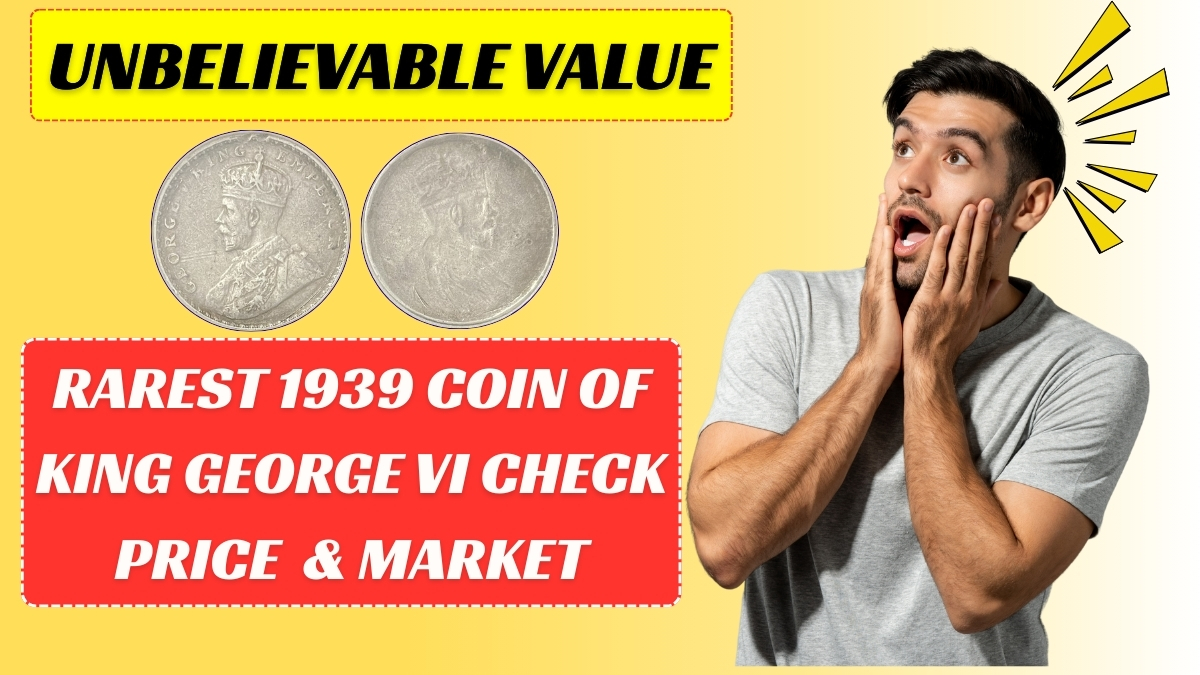1939 King George VI One Rupee: Collecting old coins is not just a hobby, but also an investment in history and heritage. Among the many coins minted during the British Raj, the 1939 One Rupee Coin King George VI holds a special place for collectors. This coin is considered rare due to its limited mintage, unique design features, and historical importance. Because of these factors, its value in the numismatic market has increased significantly over time.
In this article, we will explore the history, varieties, rarity, and current price of the 1939 One Rupee Coin featuring King George VI.
Historical Background of the 1939 One Rupee Coin
- The One Rupee Coin of 1939 was issued during the reign of King George VI, who was the Emperor of India from 1936 to 1947. Coins minted during this period carried the portrait of King George VI on one side and the denomination on the reverse.
- Obverse (Front): Features the crowned bust of King George VI facing left with the inscription “GEORGE VI KING EMPEROR” around the portrait.
- Reverse (Back): Displays the words “ONE RUPEE INDIA 1939” surrounded by a floral wreath design, with the denomination in English and Persian/Urdu script.
- The 1939 issue holds a special status because it was minted in smaller numbers compared to other years, making it highly sought after by collectors.
Rare Variety of 1939 One Rupee Coin
The 1939 rupee coin comes in different mint varieties that determine its rarity and value. Collectors carefully examine these varieties before estimating the market price.
1. Bombay Mint Issue
- Minted with a small dot (or diamond) below the date or under the floral design.
- Slightly more common than Calcutta mint issues.
2. Calcutta Mint Issue
- No mint mark, making it rare.
- Calcutta-minted 1939 coins are considered highly valuable.
3. Error Coins & Variants
- Misprints, off-center strikes, or double-die coins fetch even higher prices among collectors.
- Because of these variations, the 1939 one rupee coin King George VI is classified as a rare numismatic treasure.
Why the 1939 Rupee is Considered Rare
- Several reasons contribute to the rarity of this coin:
- Limited Mintage: Fewer coins were minted in 1939 compared to other years.
- Pre-Independence Era: Being part of British India coins, it carries historical importance.
- Silver Content: Made of 50% silver, which increases its intrinsic value.
- Collector Demand: Increasing global interest in colonial Indian coins has raised its market price.
- Current Market Price of 1939 One Rupee Coin
- The price of the 1939 One Rupee King George VI coin depends on factors like mint variety, condition, and rarity.
- Average Circulated Condition: ₹1,500 – ₹3,000
- Fine to Very Fine Condition: ₹3,500 – ₹7,000
- Extremely Fine to UNC (Uncirculated): ₹10,000 – ₹25,000
- Rare Varieties (Calcutta Mint / Error Coins): Can go up to ₹50,000 or more in auctions.
- In international coin markets, the price may vary between $100 to $500 depending on grade and demand.
- How to Identify a Genuine 1939 One Rupee Coin
- Because of its high demand, fake or replica coins are also found in the market. To ensure authenticity, collectors should check:
- Weight: Around 11.66 grams.
- Metal Composition: 50% silver, rest copper and nickel.
- Diameter: 30.6 mm approximately.
- Design Details: Sharp portrait of King George VI and clear floral wreath on the reverse.
- Mint Mark: Presence or absence of dot/diamond to determine Bombay or Calcutta mint.
- If in doubt, always consult a numismatic expert or get the coin graded by a professional coin grading service.
Collecting and Investing in Rare Coins
The 1939 One Rupee Coin is not just a collector’s item but also a good investment. Rare coins appreciate in value over time due to:
Limited availability
Growing collector interest
Historical significance
Many coin collectors in India and abroad are willing to pay a premium for well-preserved coins. Auctions and online marketplaces have seen rising demand for this particular issue.
Tips for Collectors
Always buy from trusted dealers or auction houses.
Preserve the coin in a protective holder to avoid scratches.
Avoid cleaning old coins as it reduces their numismatic value.
Stay updated with auction results and market trends to know the current price.
Conclusion
The 1939 One Rupee Coin King George VI remains a rare and highly valued piece of India’s colonial coinage. With its limited mintage, silver content, and historical significance, it has become a prized possession for collectors. Depending on condition and variety, the price of this coin can range from a few thousand rupees to tens of thousands, making it both a collectible and an investment.
also read: PNB Bank FD Scheme: How ₹2 Lakh Becomes ₹2,77,445 Best Fixed Deposit 2025
If you own a 1939 one rupee coin, especially from the Calcutta mint or with error varieties, you may be holding a small fortune. For numismatists and history lovers alike, this coin is a shining symbol of India’s rich monetary past.

